| |
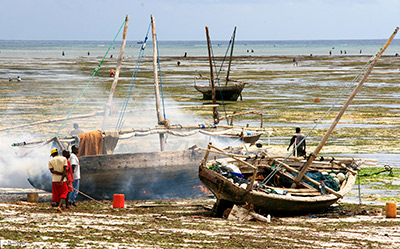
Building dhows on a Zanzibar beach
“Sorry, we have no other rooms,” the manager of the Kasha Boutique Resort said. “We are fully booked. This is what you reserved.”
We were at the northernmost hotel — and, at the time, the newest — on the east coast of the island of Zanzibar, nearly a two hour drive from Stone Town over a stone and sand track to the steel gates of the hotel. There was no where else to go.
I was traveling in Africa with a married couple, friends from home. Like many travelers, we had planned an R ‘n R stop after our safari for some quality beach time before returning stateside. We looked in dismay at the double bed with a cot rolled in next to it to make a triple. The room was typically tropical, with an open-air design, so that even the enormousbathroom stepped down into the open room. No doors. We thought we had reserved a villa with two suites and a central sitting room.
| |
“All we have are villas like this,” the manager said rather huffily. Something had been lost in translation. My choices, as the single in the group, were to sleep on one of the couches in the reception area or on the massage table in the open hut by the infinity swimming pool. The wind was blowing strong off the ocean and the idea of eight-legged creepy crawlies having unlimited access to me was not appealing. Finally, after much discussion, the manager offered to let me stay in her spare bedroom in her cottage. It was spartan, with bare light bulbs and no toilet seat, but it was a bed complete with mosquito netting. |
|
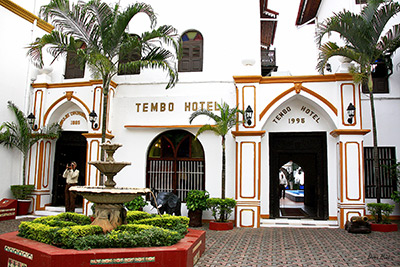 |
|
| |
|
|
Typical residence turned into a hotel |
|
Zanzibar is as exotic as its name. Known as the Spice Island, this Arab enclave lies off the coast of Tanzania in the warm waters of the Indian Ocean. At independence from Britain in 1964, Tanganyika merged with Zanzibar to form Tanzania; today Zanzibar operates as a semi- autonomous region of Tanzania.
The impact of trading merchants from India, Persia, Middle East, Indonesia, Malaysia, Africa and China since early in the first millennium made the so-called Swahili Coast of East Africa extremely wealthy and culturally advanced. Islam has been practiced since the eighth or ninth century.
The Portuguese came in 1498 and later the Sultan of Oman ruled both territories starting in 1698 through the 19th century. Both Britain and Germany wanted a piece of the Sultanate for their own empires, but control eventually came into the hands of the British Empire. As a Protectorate, the Brits kept the Sultan in place until independence.
| |
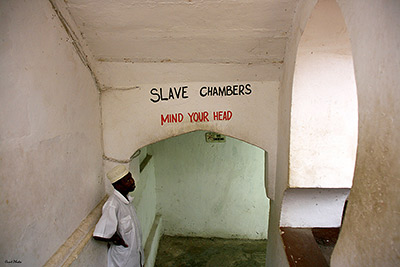 |
|
From the 1400’s until 1907, the island of Zanzibar was the center of the slave trade. Various tribespeople were brought from all parts of Africa to Zanzibar by the Arab slave traders to be sold at market and shipped to various parts of the world. Between 65 and 90 percent of the island’s population was enslaved. Records show that 718,000 slaves from the Swahili coast were exported during the 19th century, and some 769,000 were retained on the coast. Today the actual slave market is a major sightseeing stop. It's the site of the Anglican Church. |
|
| |
Former Zanzibar slave quarters |
|
|
|
A visit to the holding chambers give a feel (and a shudder) to how wretchedly cramped the conditions were. The new Heritage Center further explains that brutal period of time.
The busy streets of Stone Town, the historic center of Zanzibar City, combine the clash of African and Arab cultures with a solid addition of noisy India thrown in for good measure. Many women are completely veiled in the black head-to-toe burka while others have colorful scarves of African prints or bright Indian silks wrapped around their heads. Here, women do go out alone or with other women without the necessity of being accompanied by a male relative. They slip silently through the narrow, twisty streets of the capital.
| |
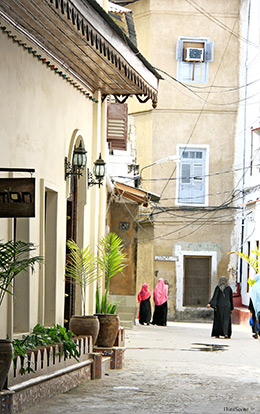 |
|
Stone Town is only about 3 km. in circumference, but the labyrinth of narrow streets, colorful markets and a hodgepodge of ruined stone buildings built close together for cool respite from the tropical island sun make the town seem endless. The fragile rock and limestone building material combined with the brutal tropical climate limits the life of most buildings to 40 or 50 years. Often, owners just build another house next door and let the old one crumble to the ground. Tucked amongst this chaos are some lovely hotels and B&Bs, most of which had been former residences. The elaborately carved wooden doors with delicately executed patterns of lotus flowers, fish and vines or dates, often studded with brass or copper, sometimes inscribed with passages from the Koran, tell a story about the household living inside. They are uniquely Zanzibar. The door is often the only outward expression of a house concealed within the courtyard beyond.
Getting lost in Stone Town is like stepping into a living museum in which the traveler becomes a part of its crumbling glory. But there is an advantage in having a guide who can relate the city’s history. |
|
| |
Stone Town |
|
|
|
If you do opt for a guide, be sure to book a tour at the office, do not hire a street hawker. For destinations outside of town, taxis or tour company drivers are fine. It is not worth the possibility of being held up by police for bribes by driving yourself.
Do stop at Jozani National Park, a small protected forest of 19 square miles that is the only location left in the world where the Red Colobus Monkey lives. They are impossible to miss, sometime coming a little too close. They are unfazed by humans and are easily seen romping in the trees.
 
Red Colobus Monkey
The near-mythical Zanzibar Leopard is so elusive no one is quite sure if it is extinct.
There are many tours available to visit one of many spice “plantations.” The main industry, aside from tourism, is the spice industry, especially for cloves, nutmeg, cinnamon, vanilla, cardamom, lemon grass and black pepper.
Our guide had made a study of the medicinal as well as culinary uses of the spices and gave us the full story. All the trees, bushes and vines are planted symbiotically, giving a general untidy appearance.
  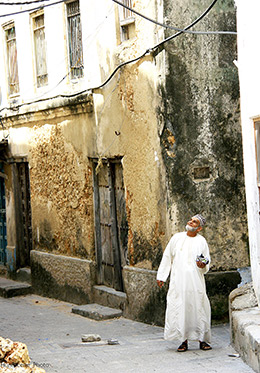
| |
Family |
|
Guide |
|
Lunch delivery |
|
It is worth the drive of several hours to the village of Nungwi at the far northern tip of the island. This is where the dhows are built, those ubiquitous fishing boats with lateen (triangular) sails. The construction site is on the beach and the building is all done by hand, using no nails, as it has been done for centuries. You’ll see the workers bending the wood for the hulls in a primitive wooden vice.
Some of the finest SCUBA diving and snorkeling are found along the Mneme Atol, along the northeast corner of Zanzibar. This reef extends along the coast at least a half mile from shore. During low tide the water is perhaps six inches deep but it is treacherous walking barefoot with zillions of spiny sea urchins and uneven rocky footing. High tide completely obliterates any beach. Beach walking is fine at low tide, but swimming in this part of the island is not recommended, no matter how inviting the promo photos look.
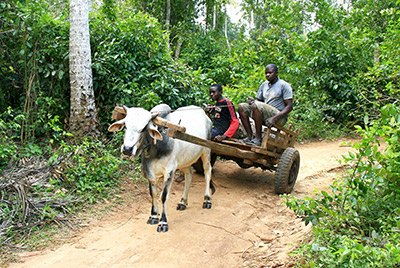 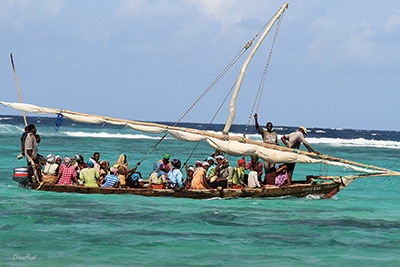
Local transportation Mass transportation
Other activities are deep sea diving, dolphin tours and kite surfing on the southeast coast. Or you can sail over to Prison Island to see the enormous tortoises shuffling through the trees.
The extreme tides also clock the comings and goings of native fishing boats.
A mass flotilla of dhows heads north early in the morning with high tide to the fishing grounds. Mid-afternoon rush hour is reversed, with hundreds, if not thousands, of small skiffs sailing on the high tide back home.
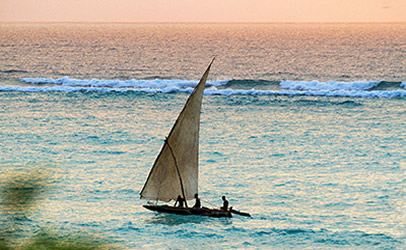 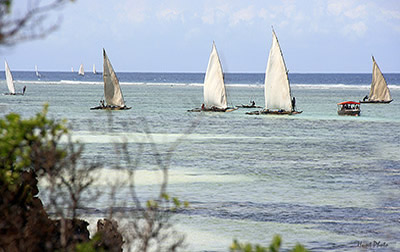 Fishing at dawn Fisherman sailing home Fishing at dawn Fisherman sailing home
Even without my own villa, sitting by the pool with a view of the Indian Ocean watching the parade of dhows, cool drink in hand, was pretty close to nirvana.
|
|
|